Today’s blog post originally appeared on the Points of Light blog site on August 21.
Michelle Nunn reflects on her families experiences at the national parks this summer.
 My son, Vinson, is a great enthusiast for earning badges and pins of any sort, so we became devotees of the Junior Ranger program as we traveled through the national parks this summer. To earn his badges, we identified sage brush, learned what Sitting Bull did during the Battle of the Little Big Horn (stayed with the women and children), and discovered how long it took to carve the figures on Mount Rushmore (14 years).
My son, Vinson, is a great enthusiast for earning badges and pins of any sort, so we became devotees of the Junior Ranger program as we traveled through the national parks this summer. To earn his badges, we identified sage brush, learned what Sitting Bull did during the Battle of the Little Big Horn (stayed with the women and children), and discovered how long it took to carve the figures on Mount Rushmore (14 years).
We talked to lots of volunteer park service rangers who helped fill us in on the key, elusive answers to the Junior Ranger challenges. The successful completion of each booklet was rewarded not only with a badge, but also a swearing-in ceremony. Vinson was led, often by a volunteer ranger, in a pledge of re-commitment to our national parks and to the preservation of our nation’s special places and spaces: “As a Junior Ranger, I promise to teach others about what I learned today, explore other parks and historic sites, and help preserve and protect these places so future generations can enjoy them.” Thus, the National Park Service is cultivating the next generation of volunteers and advocates for conservation.
Our National Park System of 397 extraordinary geological, historical and cultural wonders was built upon the 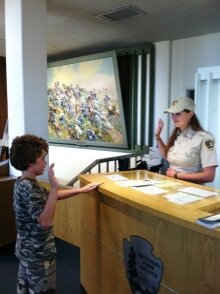 passionate advocacy of citizen activists like Ferdinand V. Hayden, Yellowstone’s first and most enthusiastic advocate, and John Muir, founder of the Sierra Club and champion of Yosemite. As documentarian Ken Burns pointed out, “You’d be hard pressed to find something that was a purer expression of the democratic impulse, in setting aside land, not for the privileged, not for the kings and nobility, but for everybody. For all time.” This extraordinary heritage was created by citizen and volunteer leaders and it continues to be protected by a network of volunteers. The National Park Service has 22,000 employees, but ten times as many volunteers – 221,000.
passionate advocacy of citizen activists like Ferdinand V. Hayden, Yellowstone’s first and most enthusiastic advocate, and John Muir, founder of the Sierra Club and champion of Yosemite. As documentarian Ken Burns pointed out, “You’d be hard pressed to find something that was a purer expression of the democratic impulse, in setting aside land, not for the privileged, not for the kings and nobility, but for everybody. For all time.” This extraordinary heritage was created by citizen and volunteer leaders and it continues to be protected by a network of volunteers. The National Park Service has 22,000 employees, but ten times as many volunteers – 221,000.
My family enjoyed national parks ranging from Glacier to the Badlands to Mount Rushmore. At each park, I was struck by the constellation of volunteers, friends groups and private donations that support the National Park System. There are young people serving as volunteer Rangers, seniors who live in state and national parks as resident volunteers, and tens of thousands of volunteers who clear trails, fight fires, teach classes and help interpret the rich history and ecology of the parks.
 The preservation of a special place like Crater Lake seems providential. But, it took three decades of advocacy and citizen leadership to make it happen. In 1870, when William Gladstone Steel was just a schoolboy, he unpacked his sandwich from its newspaper wrappings. As he ate, he read an article about an unusual lake in Oregon with startling blue water surrounded by cliffs almost 2,000 feet high. (So, perhaps it was providential). He first visited Crater Lake 15 years later and was so moved by its beauty, he began his tireless volunteer advocacy to have it preserved forever as a public park. Steele’s proposals to create a national park met with much argument from sheep herders and mining interests. He persisted and, in 1902, Crater Lake became a national park.
The preservation of a special place like Crater Lake seems providential. But, it took three decades of advocacy and citizen leadership to make it happen. In 1870, when William Gladstone Steel was just a schoolboy, he unpacked his sandwich from its newspaper wrappings. As he ate, he read an article about an unusual lake in Oregon with startling blue water surrounded by cliffs almost 2,000 feet high. (So, perhaps it was providential). He first visited Crater Lake 15 years later and was so moved by its beauty, he began his tireless volunteer advocacy to have it preserved forever as a public park. Steele’s proposals to create a national park met with much argument from sheep herders and mining interests. He persisted and, in 1902, Crater Lake became a national park.
American Pulitzer Prize-winning author Wallace Stegner wrote, “National parks are the best idea we ever had. Absolutely American, absolutely democratic, they reflect us at our best rather than our worst.” To sustain this extraordinary American legacy for all people and all time, the national parks depend on the next generation to volunteer our time, donate our money, and speak up to expand and preserve our country’s extraordinary parks. We need those Junior Rangers to take their vows to heart.

 Happy Dollar Day! Today is a day to remember the creation of the first United States dollar bill. In honor of the United States dollar bill’s birthday, we would like to discuss the importance that the dollar bill plays in the nonprofit fundraising world. It would be difficult for nonprofit organizations to accomplish all that they do without the generous support of individual and large donors.
Happy Dollar Day! Today is a day to remember the creation of the first United States dollar bill. In honor of the United States dollar bill’s birthday, we would like to discuss the importance that the dollar bill plays in the nonprofit fundraising world. It would be difficult for nonprofit organizations to accomplish all that they do without the generous support of individual and large donors.
 community and local businesses. Community members will get a feel for your organization and feel more connected to it when they have an understanding of your overall mission.
community and local businesses. Community members will get a feel for your organization and feel more connected to it when they have an understanding of your overall mission.


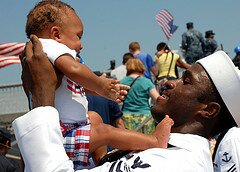
 nonprofits to bring collaborative, integrated solutions to address the most common challenges facing veterans and military families, from unemployment to education to behavioral health, housing, and reintegration. Volunteers, including veterans themselves, are the power behind the Blueprint. The Community Blueprint is the only national, scalable approach developed by a coalition of over 55 veteran and military-serving organizations nonprofits and government agencies focused on serving our nation’s military men and women and their families. To learn more check out our Community Blueprint web page!
nonprofits to bring collaborative, integrated solutions to address the most common challenges facing veterans and military families, from unemployment to education to behavioral health, housing, and reintegration. Volunteers, including veterans themselves, are the power behind the Blueprint. The Community Blueprint is the only national, scalable approach developed by a coalition of over 55 veteran and military-serving organizations nonprofits and government agencies focused on serving our nation’s military men and women and their families. To learn more check out our Community Blueprint web page!
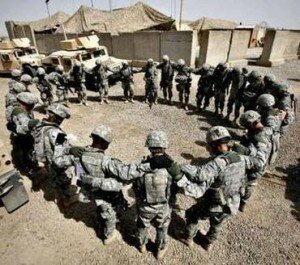
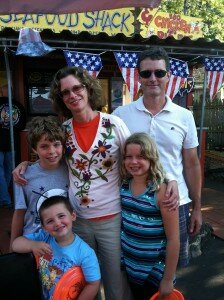 Buffalo was a terrific place to begin our journey across the country to visit with volunteers and citizen innovators. I met with community activists, AmeriCorps members and Alums who are driving civic change in Buffalo with their energy and idealism.
Buffalo was a terrific place to begin our journey across the country to visit with volunteers and citizen innovators. I met with community activists, AmeriCorps members and Alums who are driving civic change in Buffalo with their energy and idealism. percentage of the jobs retrofitting houses employ community members. Buffalo has one of the nation’s highest rates of home vacancies. A renaissance in Buffalo depends upon citizens banding together to create new approaches to economic development and healthier forms of community. This initiative is a really interesting model of authentic community organizing combined with new green approaches to economic development. It will be fascinating to see how PUSH develops in both its Green Development Zone and in its broader advocacy efforts to influence legislation and systems.
percentage of the jobs retrofitting houses employ community members. Buffalo has one of the nation’s highest rates of home vacancies. A renaissance in Buffalo depends upon citizens banding together to create new approaches to economic development and healthier forms of community. This initiative is a really interesting model of authentic community organizing combined with new green approaches to economic development. It will be fascinating to see how PUSH develops in both its Green Development Zone and in its broader advocacy efforts to influence legislation and systems.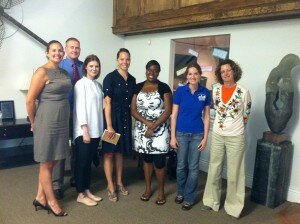


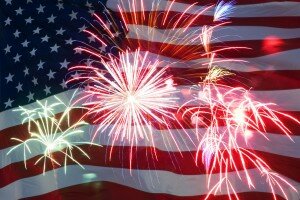 Patriotic spirit is in the air! We are only a day away from fireworks, barbeque, and everything American! Not only is the Fourth of July a great day to relax, spend time with family, and celebrate being an American, but it is also a great time to give back to your country through the act of service.
Patriotic spirit is in the air! We are only a day away from fireworks, barbeque, and everything American! Not only is the Fourth of July a great day to relax, spend time with family, and celebrate being an American, but it is also a great time to give back to your country through the act of service.
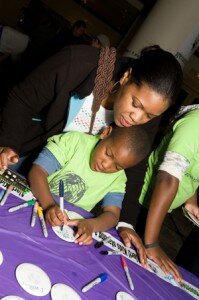 Today is a BIG day for youth service! “Why?” you ask. July 2nd is the beginning of
Today is a BIG day for youth service! “Why?” you ask. July 2nd is the beginning of  lication through the generationOn website. Kids can choose a challenge team and project ideas. Once a pledge is made, kids can also challenge their friends to be heroes through the use of social media. Once the challenge is met, kids can share their projects through video, essays, or pictures to inspire other youth. All participants will receive a certificate of completion after the project as well!
lication through the generationOn website. Kids can choose a challenge team and project ideas. Once a pledge is made, kids can also challenge their friends to be heroes through the use of social media. Once the challenge is met, kids can share their projects through video, essays, or pictures to inspire other youth. All participants will receive a certificate of completion after the project as well! school. Your child or teen can get involved in solving this important problem by making a work of art for a shelter, making a pillow buddy, hosting a princess party to collect fairytale books, making health kits, collecting school supplies boxes, advocating for the homeless, etc.
school. Your child or teen can get involved in solving this important problem by making a work of art for a shelter, making a pillow buddy, hosting a princess party to collect fairytale books, making health kits, collecting school supplies boxes, advocating for the homeless, etc.
 The world needs more action heroes, are you up to the challenge? We hope that your children will make the pledge to accept one of these eight hero challenges to better his or her community!
The world needs more action heroes, are you up to the challenge? We hope that your children will make the pledge to accept one of these eight hero challenges to better his or her community!
 Honor fallen heroes by volunteering at a veterans’ cemetery on Memorial Day or any time of year. Volunteers can give cemetery tours, help with maintenance, raise and lower flags and more. Use the
Honor fallen heroes by volunteering at a veterans’ cemetery on Memorial Day or any time of year. Volunteers can give cemetery tours, help with maintenance, raise and lower flags and more. Use the  volunteers is working to bring floral beauty to the graves at this Memorial Day. This Monday, May 28, more than 100 volunteers from Memorial Day Flowers will hand out more than 50,000 roses at the cemetery. Visitors are given two roses, one to place on a grave, and one to take home in remembrance. All of the flowers are donated by farmers throughout Ecuador. The idea was initiated by Ramiro Peñaherrera of
volunteers is working to bring floral beauty to the graves at this Memorial Day. This Monday, May 28, more than 100 volunteers from Memorial Day Flowers will hand out more than 50,000 roses at the cemetery. Visitors are given two roses, one to place on a grave, and one to take home in remembrance. All of the flowers are donated by farmers throughout Ecuador. The idea was initiated by Ramiro Peñaherrera of 
